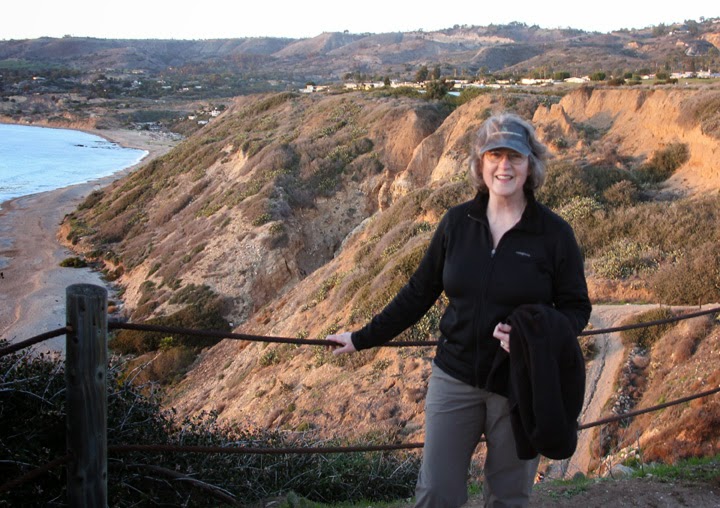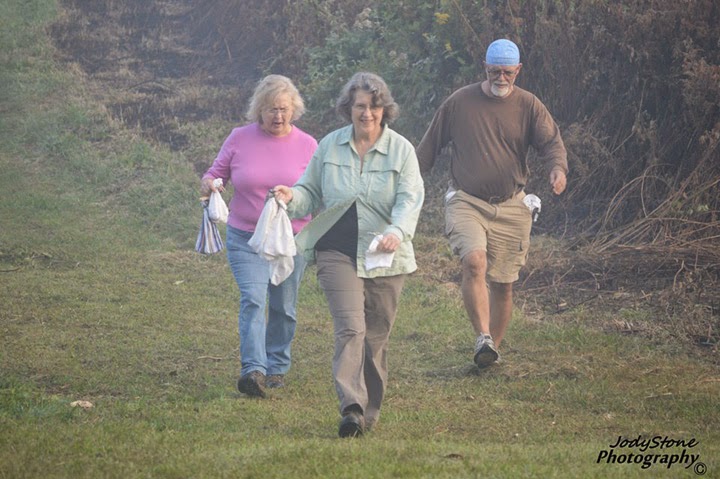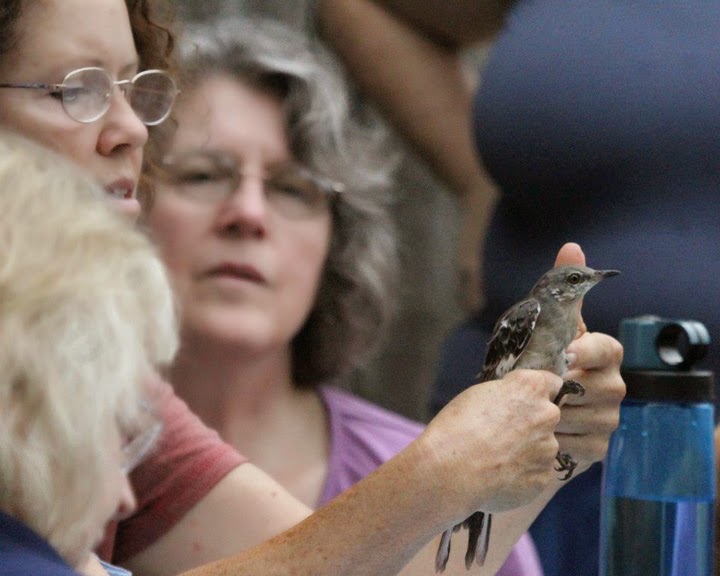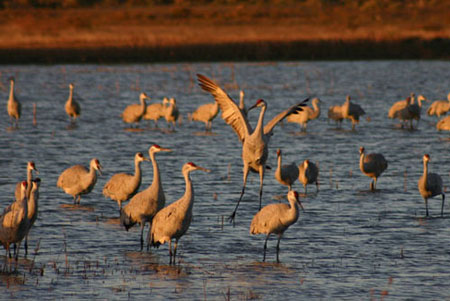It was a different kind of morning. The air was cooler, breezier, overcast.

I took my cup of coffee and my camera outside, knowing it was the last day I would get to observe hummingbirds before leaving for Wisconsin.

I first spotted The King, our resident male ruby-throated hummingbird, high on his perch, fluffed up and pensive. A short time later, after warning off a visitor, he dropped down to the holly as he is prone to do when it’s windy. He sat there quietly plumped up for a long while in the dim morning light.

A Carolina wren, who also likes this perch, displaced him for a short time, but since this busy songster can never be still, he was soon gone and The King returned.

When I next observed, an hour or so later, the stillness was palpable. I can’t explain how I knew, but I knew. He was gone. I looked for him at his perches, watched for any movement among the limbs, waited for the faintest sound of chirping from above. Nothing. Then the parade of visitors came, among them the young and inexperienced, the late fledglings.

If I needed any confirmation, I had it. They approached the feeder chirping, awkwardly stabbing for a drink, lingering for many tries, more than I had observed before. No King pounced on them or chased them away.

Were it not for the heartening comedy put on by this new generation, I might have slumped into dispair. They reminded me of an infant first discovering his hands, eager to use them, but not quite skilled enough to know how. Much the same, they approached the feeder from every angle, awkwardly missing, backing up, trying again. Endearing, especially knowing all they must master before they, too, begin their southward journey.

Fall migration. It is that wonderful, stirring time of year. The King has departed. I so wish him a safe and speedy journey. I wish this for them all.
 I can see the ruby-throated hummingbird migrants from my window as I type and sometimes I step out into the sunshine to sit for a while. The antics of the juveniles give me a chuckle-break, like when they sit on top of the feeder with their backs straight and tall, soldier-like.
I can see the ruby-throated hummingbird migrants from my window as I type and sometimes I step out into the sunshine to sit for a while. The antics of the juveniles give me a chuckle-break, like when they sit on top of the feeder with their backs straight and tall, soldier-like. Or other times, leaning back taking in everything around them.
Or other times, leaning back taking in everything around them.  And when I look at my images, it never ceases to amaze me that their wings beat faster than the shutter speed.
And when I look at my images, it never ceases to amaze me that their wings beat faster than the shutter speed. Visitors to the feeder are thinning out each day as the air is getting colder and the leaves turning to fall hues.
Visitors to the feeder are thinning out each day as the air is getting colder and the leaves turning to fall hues. But I don't lack company as I observe. My five-lined skink neighbors frequently join me, sometimes more than one of them, in pursuit of another. Tiny ones no bigger around than a pencil and longer, slightly bigger ones.
But I don't lack company as I observe. My five-lined skink neighbors frequently join me, sometimes more than one of them, in pursuit of another. Tiny ones no bigger around than a pencil and longer, slightly bigger ones. Humm...where does this one think he's going?
Humm...where does this one think he's going? That's my door...
That's my door...

 Our Atlas of the Breeding Birds of Tennessee, by Charles P. Nicholson, is non-specific about when the last ruby-throated hummers depart TN, saying, “The hummingbird…usually arrives by mid-April and departs by early October.” The former agrees with my observations this spring. And though I didn’t record my last sighting in 2007, my last photograph of a hummer was taken on the 29th of September. I’ll be observing more carefully this year.
Our Atlas of the Breeding Birds of Tennessee, by Charles P. Nicholson, is non-specific about when the last ruby-throated hummers depart TN, saying, “The hummingbird…usually arrives by mid-April and departs by early October.” The former agrees with my observations this spring. And though I didn’t record my last sighting in 2007, my last photograph of a hummer was taken on the 29th of September. I’ll be observing more carefully this year. Some twittering in the branches also caught my attention while outside and though there was no flutey song to confirm his identity, this migrating
Some twittering in the branches also caught my attention while outside and though there was no flutey song to confirm his identity, this migrating  It is so hushed right now while I am writing this. Even the robins, chickadees and blue jays are silently listening to the drizzle. A very wet and fall-ish feeling day.
It is so hushed right now while I am writing this. Even the robins, chickadees and blue jays are silently listening to the drizzle. A very wet and fall-ish feeling day. This post has been linked to
This post has been linked to  These are the words of biologist, Robert Allen, in his Audubon monograph, The Whooping Crane, September 30, 1950, when this species population numbered less than 20. While working on a children’s book project about whooping cranes, I have turned to this monograph from time to time for information.
These are the words of biologist, Robert Allen, in his Audubon monograph, The Whooping Crane, September 30, 1950, when this species population numbered less than 20. While working on a children’s book project about whooping cranes, I have turned to this monograph from time to time for information.  As I did so recently, I stumbled across this account:
As I did so recently, I stumbled across this account: The palette of cinnamon among new white feathers and black wing-tips is truly beautiful on whooping crane fledglings. Add to this combination a young peeping voice and magestic wings that span nearly seven feet and you have glimpsed some of the wonder of this tallest bird in North America.
The palette of cinnamon among new white feathers and black wing-tips is truly beautiful on whooping crane fledglings. Add to this combination a young peeping voice and magestic wings that span nearly seven feet and you have glimpsed some of the wonder of this tallest bird in North America.  Gradually, by the end of their first year, these young whooping cranes lose their cinnamon feathers and develop the facial mask that is characteristic of adults.
Gradually, by the end of their first year, these young whooping cranes lose their cinnamon feathers and develop the facial mask that is characteristic of adults. They also lose their peeping voice and develop the distinctive
They also lose their peeping voice and develop the distinctive  While visiting Necedah for
While visiting Necedah for  Among the other white birds we viewed was this family of trumpeter swans.
Among the other white birds we viewed was this family of trumpeter swans. Not only was it a pleasant surprise to get a glimpse of this family, the photo itself was a surprise.
Not only was it a pleasant surprise to get a glimpse of this family, the photo itself was a surprise. It was taken from a moving vehicle with the camera stretched across another passenger to access the open window. I have to give the credit here to my talented camera, the amazing Canon Rebel Xti!
It was taken from a moving vehicle with the camera stretched across another passenger to access the open window. I have to give the credit here to my talented camera, the amazing Canon Rebel Xti! There are three signets in the photo but you have to look a bit more carefully to find the third.
There are three signets in the photo but you have to look a bit more carefully to find the third.  There were many wonderful things to see at the refuge that I missed and will look forward to seeing the next visit, among them the endangered gray wolves and karner blue butterflies.
There were many wonderful things to see at the refuge that I missed and will look forward to seeing the next visit, among them the endangered gray wolves and karner blue butterflies. But black-eyed Susans and blue asters were easily accessible, scattered along forest edges and meadows, never failing to catch my attention.
But black-eyed Susans and blue asters were easily accessible, scattered along forest edges and meadows, never failing to catch my attention. Soothing to the eye and close at hand, their splash of color complimented a rich landscape rapidly changing into fall foliage.
Soothing to the eye and close at hand, their splash of color complimented a rich landscape rapidly changing into fall foliage.

 The sight of these birds never ceases to thrill me. I have had the good fortune of visiting the wild whooping crane population at Aransas National Wildlife Refuge on the gulf coast of Texas and this week, the re-introduced wild population at Necedah National Wildlife Refuge in Wisconsin, and I am grateful every day for the men and women whose dedication and persistence have helped this species recover from the brink of extinction.
The sight of these birds never ceases to thrill me. I have had the good fortune of visiting the wild whooping crane population at Aransas National Wildlife Refuge on the gulf coast of Texas and this week, the re-introduced wild population at Necedah National Wildlife Refuge in Wisconsin, and I am grateful every day for the men and women whose dedication and persistence have helped this species recover from the brink of extinction. A natural survival mechanism combined with man's innovation has made this eastern migratory population possible. Through a natural instinct called imprinting, a newly hatched chick bonds with and follows the first figure that it sees. It is this natural instinct that makes it possible for captive reared hatchlings to accept costumes and ultralights as though they were parents, so that migration training can occur.
A natural survival mechanism combined with man's innovation has made this eastern migratory population possible. Through a natural instinct called imprinting, a newly hatched chick bonds with and follows the first figure that it sees. It is this natural instinct that makes it possible for captive reared hatchlings to accept costumes and ultralights as though they were parents, so that migration training can occur. I positioned myself at the bottom of the tower the morning of Necedah's Cranefest.
I positioned myself at the bottom of the tower the morning of Necedah's Cranefest. It offers a different perspective and some challenges...hungry mosquitos and high foliage.
It offers a different perspective and some challenges...hungry mosquitos and high foliage. But both tower level and ground level give you excellent views.
But both tower level and ground level give you excellent views. Mature whooping cranes are white with black wing tips, a bare patch of red skin on the top of their head and a black facial mask.
Mature whooping cranes are white with black wing tips, a bare patch of red skin on the top of their head and a black facial mask. Juvenile whooping cranes still have cinnamon feathers on their head, neck and body and no facial mask.
Juvenile whooping cranes still have cinnamon feathers on their head, neck and body and no facial mask. There will be 15 juvenile whooping cranes and four ultralight parents beginning their migration south on October 17 or as weather permits. This will add another generation of whooping cranes to the world's rarest crane species. You can follow their journey by viewing Operation Migration's
There will be 15 juvenile whooping cranes and four ultralight parents beginning their migration south on October 17 or as weather permits. This will add another generation of whooping cranes to the world's rarest crane species. You can follow their journey by viewing Operation Migration's  Click here for more posts on
Click here for more posts on  Part of our whooping crane class of 2008 being led in practice by Operation Migration pilot, Chris Gullikson, on Friday morning.
Part of our whooping crane class of 2008 being led in practice by Operation Migration pilot, Chris Gullikson, on Friday morning. Below a view of the refuge from the observation tower, an area normally covered in water that has been drained temporarily to promote the release and distribution of wetland nutrients.
Below a view of the refuge from the observation tower, an area normally covered in water that has been drained temporarily to promote the release and distribution of wetland nutrients. Blue asters found all around the refuge. The flowers are about the size of a dime and come in delicate shades of blue.
Blue asters found all around the refuge. The flowers are about the size of a dime and come in delicate shades of blue.
 I took my cup of coffee and my camera outside, knowing it was the last day I would get to observe hummingbirds before leaving for Wisconsin.
I took my cup of coffee and my camera outside, knowing it was the last day I would get to observe hummingbirds before leaving for Wisconsin.  I first spotted The King, our resident male ruby-throated hummingbird, high on his perch, fluffed up and pensive. A short time later, after warning off a visitor, he dropped down to the holly as he is prone to do when it’s windy. He sat there quietly plumped up for a long while in the dim morning light.
I first spotted The King, our resident male ruby-throated hummingbird, high on his perch, fluffed up and pensive. A short time later, after warning off a visitor, he dropped down to the holly as he is prone to do when it’s windy. He sat there quietly plumped up for a long while in the dim morning light. A Carolina wren, who also likes this perch, displaced him for a short time, but since this busy songster can never be still, he was soon gone and The King returned.
A Carolina wren, who also likes this perch, displaced him for a short time, but since this busy songster can never be still, he was soon gone and The King returned. 
 If I needed any confirmation, I had it. They approached the feeder chirping, awkwardly stabbing for a drink, lingering for many tries, more than I had observed before. No King pounced on them or chased them away.
If I needed any confirmation, I had it. They approached the feeder chirping, awkwardly stabbing for a drink, lingering for many tries, more than I had observed before. No King pounced on them or chased them away. Were it not for the heartening comedy put on by this new generation, I might have slumped into dispair. They reminded me of an infant first discovering his hands, eager to use them, but not quite skilled enough to know how. Much the same, they approached the feeder from every angle, awkwardly missing, backing up, trying again. Endearing, especially knowing all they must master before they, too, begin their southward journey.
Were it not for the heartening comedy put on by this new generation, I might have slumped into dispair. They reminded me of an infant first discovering his hands, eager to use them, but not quite skilled enough to know how. Much the same, they approached the feeder from every angle, awkwardly missing, backing up, trying again. Endearing, especially knowing all they must master before they, too, begin their southward journey. Fall migration. It is that wonderful, stirring time of year. The King has departed. I so wish him a safe and speedy journey. I wish this for them all.
Fall migration. It is that wonderful, stirring time of year. The King has departed. I so wish him a safe and speedy journey. I wish this for them all.
 Sometimes he could care less about my presence. Other times, he chirps and zips to the other side of the feeder, or even switches to a different feeder out of range. Today I got some lucky shots.
Sometimes he could care less about my presence. Other times, he chirps and zips to the other side of the feeder, or even switches to a different feeder out of range. Today I got some lucky shots.  Don't you just love those irridescent feathers?
Don't you just love those irridescent feathers? And the tuffs of white poking out from beneath his belly?
And the tuffs of white poking out from beneath his belly? I set out to observe today and confirm he was still around. I'm curious about when he will begin
I set out to observe today and confirm he was still around. I'm curious about when he will begin 







